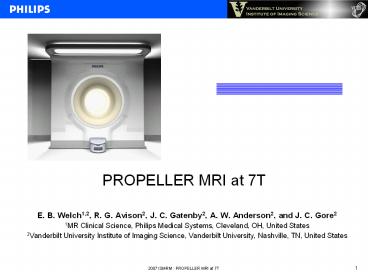PROPELLER MRI at 7T PowerPoint PPT Presentation
1 / 10
Title: PROPELLER MRI at 7T
1
PROPELLER MRI at 7T
- E. B. Welch1,2, R. G. Avison2, J. C. Gatenby2, A.
W. Anderson2, and J. C. Gore2 - 1MR Clinical Science, Philips Medical Systems,
Cleveland, OH, United States - 2Vanderbilt University Institute of Imaging
Science, Vanderbilt University, Nashville, TN,
United States
2
Introduction
- The utility of PROPELLER (MRM Pipe 1999, General
Electric) a.k.a. BLADE (Siemens) a.k.a. MULTIVANE
(Philips) at clinical field strengths is
well-known - In this work, the static image quality of
multivane data sets is explored for several
acquisitions of human brain at 7.0T, specifically - multi-slice 2D T2W TSE
- 3D T1W TFE
- 3D T2W FFE
- 3 male subjects who gave informed consent under
IRB approval were scanned - Subjects remained motionless while both cartesian
and multivane scans were performed
3
Methods Data Acquisition Reconstruction
- A custom software patch was implemented on a
Philips Achieva 7T whole body scanner (Philips
Medical Systems, Cleveland, Ohio) to acquire
multivane data - The individual 3D vanes (T1W TFE and T2W FFE
datasets) were collected as low-resolution (ky
direction) 3D volumes that rotated about the kz
direction only - Multivane images were reconstructed on the
scanners console computer using ReconFrame
(Gyrotools Inc., Zurich, Switzerland) - k-space sampling density weights were calculated
using the known geometry of the vanes (Devaraj,
et al. Proc. ISMRM 2006 p.2956) - No motion correction algorithm was applied
4
Methods - Pulse Sequences
2D T2W TSE 3D T1W TFE 3D T2W FFE
Acquisition Matrix Size 512 x 512 x 8 512 x 512 x 26 512 x 512 x 21
TR/TE msec 3500/60 5.6/2.9 32/19
k-space lines/vanes 24 128 (x 26 kz) 24 (x 21 kz)
Number of vanes 34 7 34
Vane acquisition time 240 msec 26 x 3000 msec (TFE shot interval) 78.0 sec 24 x 21 x 32 msec 16.1 sec
Cartesian/Multivane acquisition time mmss 522/756 511/905 544/915
5
Results T2W TSE
CARTESIAN
MULTIVANE
6
Results T1W TFE
CARTESIAN
MULTIVANE
7
Results T2W FFE
CARTESIAN
MULTIVANE
8
Results artifacts rotating with vane direction
T1W TFE in-plane image registration tricked
by fat ring. Original vane images (left) show
static brain tissue with moving fat, but the
registered vane images (right) have made the fat
static and caused the brain tissue to move
image registration (motion correction algorithm)
was not used for full reconstructions
T1W TFE fat shift rotates
T2W TSE Susceptibility artifact rotates (dark
areas near left and right edge of brain)
9
Discussion Conclusion
- 7T multivane images of static neuro anatomy have
comparable contrast and quality when compared to
the equivalent cartesian images - Multivane images appear smoother in most cases
likely due to the point spread function inherent
to the multivane k-space sampling pattern - Considering the slight blurring and the increased
scan time (at least 157 for Nyquist-sampling) of
multivane images vs. the cartesian equivalent,
multivane may not be desirable for cooperative
(static) subjects - Future work will test if the application of a
motion correction algorithm makes multivane
desirable over cartesian at 7T in the presence of
motion, though care should be taken to
account/compensate for the rotating chemical
shift and susceptibility artifacts (stronger at
7T than at clinical field strengths)
10
Discussion Conclusion
- 3D multivane datasets which are low resolution in
ky, full resolution in kz direction and rotated
about the kz axis can be collected and
reconstructed - Acquisition time of a 3D vane is much longer than
for single-shot 2D vane, but is short compared to
the total scan time of high resolution 3D image
volumes - A truer 3D multivane acquisition would rotate
the kx-ky-kz rod in all 3 directions (see
animation on right) and is the subject of future
study
Theoretical k-space trajectory for true 3D
MULTIVANE
Acknowledgements Gyrotools Inc., Zurich,
Switzerland (Sebastian Kozerke) for access to
ReconFrame. John C. Gore, VUIIS director, for 7T
scanner access.

